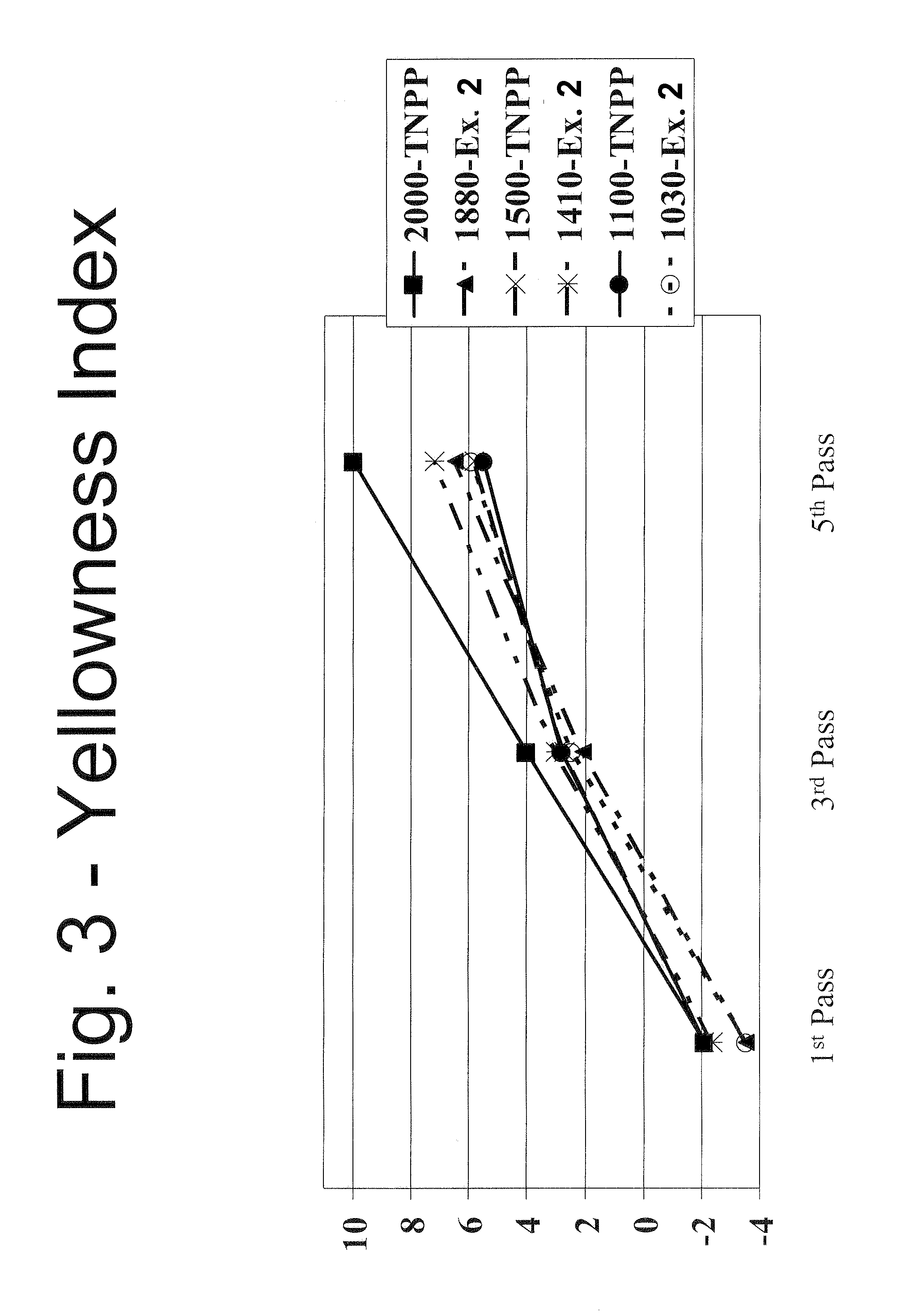Mixed alkyl-alklaryl-phenyl phosphite polymer additive
a technology of alkyl-alklarylphenyl phosphite and polymer additive, which is applied in the field of mixed alkyl-alklarylphenyl phosphite polymer additive, can solve the problems of estrogenic activity and other problems
- Summary
- Abstract
- Description
- Claims
- Application Information
AI Technical Summary
Benefits of technology
Problems solved by technology
Method used
Image
Examples
example # 1
Example #1
1 Mol Para-Cumylphenol / 2 mol 2-propylheptanol Phosphite (Mixed 2-propylheptyl, p-cumylphenyl phosphite)
[0064]To a three-neck 3000 mL flask equipped with a magnetic stirrer, a distillation column connected to a receiver and a vacuum system was added of 2-propylheptanol (750 g, 4.75 mol), para-cumylphenol (504 g, 2.38 mol), triphenyl phosphite (736 g, 2.37 mol), and 0.5 grams of sodium methoxide. The mixture was mixed well and heated to 150-152° C. under nitrogen and held at the temperature for 1 hour. The pressure was then gradually reduced to 0.3 mm Hg and the temperature was increased to 170-172° C. over a course of 1 hour. The reaction contents were held at 160-162° C. under the vacuum for approximately 2 hours at which point no more phenol was distilling out. The vacuum was then broken by nitrogen and the crude product was cooled to ambient temperature. To the product 1 gram of Celite 545 filter aid was added and mixed for 0.5 hours. The product was then suction filtere...
example # 2
Example #2
1&2 mol Para-Cumylphenol, 2&1 mol C12-14 Alcohol Phosphite (Mixed C12-14 alkyl, p-cumylphenyl phosphite)
[0065]To a three-neck 500 mL flask equipped with a magnetic stirrer, a distillation column connected to a receiver and a vacuum system was added a mixture of lauryl and myristyl alcohol with a hydroxyl number of about 280 (65 g, 0.325 mol), para-cumylphenol (137 g, 0.646 mol), triphenyl phosphite (100 g, 0.322 mol), and 0.5 grams of sodium methoxide. The mixture was mixed well and heated to 150-152° C. under nitrogen and held at the temperature for 1 hour. The pressure was then gradually reduced to 0.3 mmHg and the temperature was increased to 170-172° C. over a course of 1 hour. The reaction contents were held at 160-162° C. under the vacuum for approximately 2 hours at which point no more phenol was distilling out. The vacuum was then broken by nitrogen and the crude product was cooled to ambient temperature. To the product 0.5 gram of Celite 545 filter aid was added a...
example # 3
Example #3
1&2 mol Para-Cumylphenol, 2&1 mol Isodecyl Alcohol Phosphite (Mixed C10 alkyl, p-cumylphenyl phosphite)
[0066]To a three-neck 5000 mL flask equipped with a magnetic stirrer, a distillation column connected to a receiver and a vacuum system was added of Isodecyl alcohol (1152 g, 7.291 mol), para-cumylphenol (1547 g, 7.297 mol), triphenyl phosphite (1552 g, 5.01 mol), and 3.0 grams of sodium methoxide. The mixture was mixed well and heated to 150-152° C. under nitrogen and held at the temperature for 1 hour. The pressure was then gradually reduced to 0.3 mmHg and the temperature was increased to 170-172° C. over a course of 1 hour. The reaction contents were held at 160-162° C. under the vacuum for approximately 2 hours at which point no more phenol was distilling out. The vacuum was then broken by nitrogen and the crude product was cooled to ambient temperature. To the product 15 gram of Celite 545 filter aid was added and mixed for 0.5 hour. The product was then suction fil...
PUM
| Property | Measurement | Unit |
|---|---|---|
| Percent by mass | aaaaa | aaaaa |
| Substance count | aaaaa | aaaaa |
| Temperature | aaaaa | aaaaa |
Abstract
Description
Claims
Application Information
 Login to View More
Login to View More - R&D
- Intellectual Property
- Life Sciences
- Materials
- Tech Scout
- Unparalleled Data Quality
- Higher Quality Content
- 60% Fewer Hallucinations
Browse by: Latest US Patents, China's latest patents, Technical Efficacy Thesaurus, Application Domain, Technology Topic, Popular Technical Reports.
© 2025 PatSnap. All rights reserved.Legal|Privacy policy|Modern Slavery Act Transparency Statement|Sitemap|About US| Contact US: help@patsnap.com



